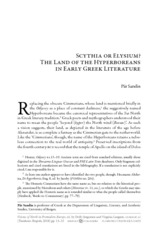| dc.contributor.author | Sandin, Pär Ola | |
| dc.contributor.editor | Jørgensen, Dolly | |
| dc.contributor.editor | Langum, Virginia | |
| dc.date.accessioned | 2018-06-28T11:01:04Z | |
| dc.date.available | 2018-06-28T11:01:04Z | |
| dc.date.issued | 2018 | |
| dc.Published | In: Jørgensen, D. and Langum, V. (eds.), Visions of North in Premodern Europe, pp. 13-33 | |
| dc.identifier.isbn | 978-2-503-57476-9 | |
| dc.identifier.issn | 2034-1660 | |
| dc.identifier.issn | 2565-943X | |
| dc.identifier.uri | https://hdl.handle.net/1956/17845 | |
| dc.description.abstract | In Ionic literary tradition, the Hyperborean people are more or less consistently portrayed as ethnically and geographically Scythian. Several details in the tenth Pythian and third Olympian odes, including the location of the Hyperboreans in a mountainous region in the far West, their sacrifice of asses, and their cultural and religious practices otherwise similar to those of the Greeks, indicate that Pindar intentionally disputed this view, trying to render the Hyperboreans as distinctly non-Scythian as possible. Pindar’s interpretation of the existence of the Hyperboreans as supernatural, which is not found in Ionic and Attic sources, is in line with the greater veneration afforded to the god Apollo in Doric Greek culture. | en_US |
| dc.language.iso | eng | eng |
| dc.publisher | Brepols | eng |
| dc.relation.ispartofseries | Cursor Mundi; 31 | eng |
| dc.subject | Hyperboreans | eng |
| dc.subject | Scythia | eng |
| dc.subject | Pindar | eng |
| dc.title | Scythia or Elysium? The Land of the Hyperboreans in Early Greek Literature | eng |
| dc.type | Chapter | |
| dc.type | Peer reviewed | |
| dc.description.version | publishedVersion | |
| dc.rights.holder | Copyright Brepols Publishing | eng |
| dc.identifier.doi | https://doi.org/10.1484/m.cursor-eb.5.114055 | |
